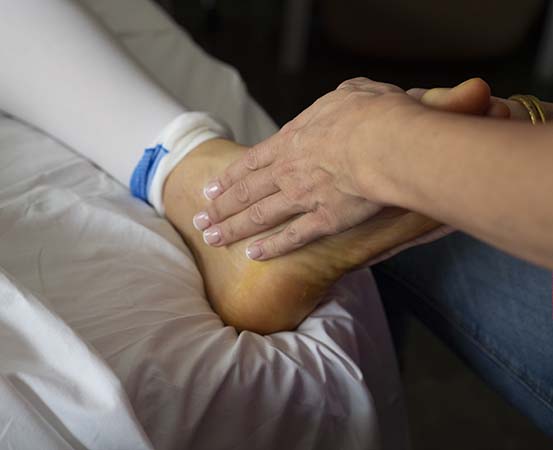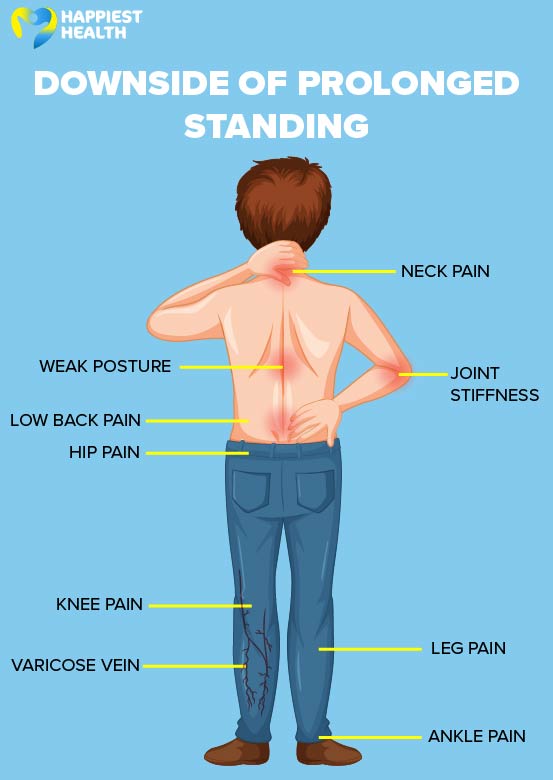
Much like sitting for long durations, prolonged standing could also lead to many physical issues. There are many people — among them police officers, doctors, bartenders, bus conductors and teachers — whose profession requires them to stand for long periods.
Prolonged standing is when you stand more than four to five hours a day or remain stagnant standing for two hours. Stagnant standing is the new sitting, say, experts, and is equally harmful.
“Posture while standing needs to be correct,” says Dr Kiran Chouka, consultant orthopaedic, joint replacement and arthroscopic surgeon, Manipal Hospitals, Bengaluru. “The centre of gravity should be located at the mid-section of the body, and you should stand erect. If a person bends forward or backwards and stands, it might lead to hunchback and lower back ache.”
Downsides of prolonged standing
Standing for long durations can cause swelling and inflammation of the lower limbs. Over a period, it could lead to varicose veins and subsequently deep vein thrombosis — a blood clot that forms in the deep veins of the legs.
Dr Sandeep Ghanta, consultant of internal medicine, Citizens Speciality Hospital, Hyderabad, lists out some other effects of prolonged standing. “It leads to heart-related conditions, complicated pregnancy, fatigue, discomfort, joint pain, stiffness [hip, knee, and ankle], back pain and weakening of the posture,” he says.
According to the Canadian Centre for Occupational Health and Safety, prolonged standing reduces blood supply to the muscles, leading to fatigue and pain in the back, legs and neck. Standing without relief can lead to pooling of the blood in the legs and the feet, which causes inflammation of the veins. This can lead to varicose veins. It can also cause temporary immobilisation of the joints and could lead to rheumatic conditions.

Stand at ease
Professionals who have no choice but to stand and work can reduce the consequences of prolonged standing by following certain basic tenets.
First and foremost is to take regular breaks. “After every 20 minutes of standing, people should stretch and take a break for two to five minutes and get back to the work again,” says Dr Chouka.
Staying hydrated, sticking to a nutritious diet and maintaining optimal body weight all help in getting the body stronger to cope with the strains of standing for long durations. Prevention is better than cure. So, it is a good idea to maintain a workout routine with yoga asanas — such as surya namaskar, which develops core strength, and the cat-cow pose (for the lower back) — and exercises to strengthen the quadriceps, hamstrings and lower limbs.
Preventive measures also include wearing stockings from thigh to toe or comprehensive bandages (they help pull the blood back to the heart) and ensuring comfortable footwear. For comfort, people can opt for sports shoes or shoes with soft soles or silicon soles — and preferably wear a pair that is a size bigger.
To avoid or cope with back pain, you can wear a back support belt too. However, the key remains to not stand for long durations, and keep moving, using movement as a form of taking an active break.
Takeaways
- There are professionals whose work demands prolonged standing, which can have an adverse effect on their health, much like sitting for too long.
- Standing for long durations can lead to heart conditions, weak muscles, joint pain, varicose veins, complicated pregnancy and other physical issues.
- Wearing stockings or compressed bandages, proper and comfortable footwear, and taking breaks by moving frequently can reduce the impact of prolonged standing on the body.

















